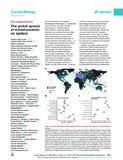| dc.contributor.author | Mammola, S. et al. | |
| dc.contributor.author | Warui, Charles M. | |
| dc.date.accessioned | 2022-08-24T09:25:44Z | |
| dc.date.available | 2022-08-24T09:25:44Z | |
| dc.date.issued | 2022-08-22 | |
| dc.identifier.citation | Current Biology Volume 32, Issue 16, 22 August 2022, Pages R871-R873 | en_US |
| dc.identifier.uri | https://www.sciencedirect.com/science/article/pii/S0960982222011277 | |
| dc.identifier.uri | http://hdl.handle.net/123456789/6119 | |
| dc.identifier.uri | https://doi.org/10.1016/j.cub.2022.07.026 | |
| dc.description.abstract | In the internet era, the digital architecture that keeps us connected and informed may also amplify the spread of misinformation. This problem is gaining global attention, as evidence accumulates that misinformation may interfere with democratic processes and undermine collective responses to environmental and health crises1,2. In an increasingly polluted information ecosystem, understanding the factors underlying the generation and spread of misinformation is becoming a pressing scientific and societal challenge3. Here, we studied the global spread of (mis-)information on spiders using a high-resolution global database of online newspaper articles on spider–human interactions, covering stories of spider–human encounters and biting events published from 2010–20204. We found that 47% of articles contained errors and 43% were sensationalist. Moreover, we show that the flow of spider-related news occurs within a highly interconnected global network and provide evidence that sensationalism is a key factor underlying the spread of misinformation. | en_US |
| dc.language.iso | en | en_US |
| dc.publisher | ScienceDirect | en_US |
| dc.title | The global spread of misinformation on spiders | en_US |
| dc.type | Article | en_US |

